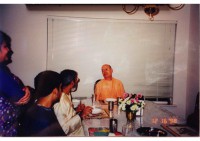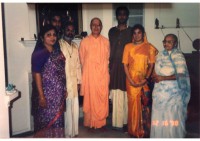HG Narottamananda Prabhu / SB 10.87.29
More about Mantra and Meaning…
→ The Enquirer
I recently made a post about the importance of understanding the meaning of a mantra. Among the repies I got these inquiries…
I think mantra is not what we vibrate with our mouth because that is purelly a mechanic activity. And hearing a mantra is not about receiving sound waves with eardrums, another mechanic interaction from the outside.
This is very dualistic – as if the “inside” has nothing to do with the “outside.” If you take that out, and add the word “just” or “only” then your conclusion makes more sense to me. I would say it like this: “Mantra is not just what we vibrate with our mouths or hear with our eardrums…”
I think the “sound” itself is not understood with mechanic vibrations of the air but the sound is the words which we create in our counsciousness.
The most important part of the mantra is the meaning you receive from the sound, but the sound itself is also important because it symbolically carries the meaning.
The sound waves are symbols carrying meaning/understanding, like the wind carries a breeze. Words don’t need to be audible. They can be written or simply pronounced by the mental voice to the mental ear.
But “the mind” is also a brain or a subtle body, so it is also an external thing.
Yes! That’s why the dualism of “external/internal” is not realistic. The external is a projection of what is internal. Therefore the external and internal are inter-related and affect one another. Thus an external sense perception, or a mental recollection of it, affects the internal state of consciousness and ultimately can be witnessed/experienced by the ātma itself.
Hari nāma is a state of consciousness where you want to chant the hari nāma.
It is not just a state of consciousness. It is actually a word, a name. But this word-name cannot be heard or chanted perfectly without a perfect state of consciousness. Hari nāma is a transcendental entity, so it cannot be produced by an ignorant tongue, nor heard by an ignorant ear. Only the absolutely pure ātmā drenched in śuddha-sattva can hear or enunciate the real names of Krishna.
The endeavor to hear and chant this word-name, however, purifies the consciousness gradually. So the method for eventually hearing and speaking the true spiritual names of Krishna is to practice hearing and speaking the external approximations of those names.
I have heared that the chanting of a pure devotee can set everyone who hears it free of material desires.
A pure soul would be able to chant the true name of Krishna, so this would have a profound effect. Just like if you hear someone explain something they really understand, it is more profound and you can understand it more easily then when someone who doesn’t really grasp the subject tries to explain it.
Hearing the name enunciated by a pure soul would make a very profound impact on us, making us really desire strongly to understand what that person experiences. This would propel us in bhakti-yoga very strongly by giving a very, very strong śraddha (conviction in the value and worth of Krishna).
Vraja Kishor
Tagged: Mantra, meaning, words
More about Mantra and Meaning…
→ The Enquirer
I recently made a post about the importance of understanding the meaning of a mantra. Among the repies I got these inquiries…
I think mantra is not what we vibrate with our mouth because that is purelly a mechanic activity. And hearing a mantra is not about receiving sound waves with eardrums, another mechanic interaction from the outside.
This is very dualistic – as if the “inside” has nothing to do with the “outside.” If you take that out, and add the word “just” or “only” then your conclusion makes more sense to me. I would say it like this: “Mantra is not just what we vibrate with our mouths or hear with our eardrums…”
I think the “sound” itself is not understood with mechanic vibrations of the air but the sound is the words which we create in our counsciousness.
The most important part of the mantra is the meaning you receive from the sound, but the sound itself is also important because it symbolically carries the meaning.
The sound waves are symbols carrying meaning/understanding, like the wind carries a breeze. Words don’t need to be audible. They can be written or simply pronounced by the mental voice to the mental ear.
But “the mind” is also a brain or a subtle body, so it is also an external thing.
Yes! That’s why the dualism of “external/internal” is not realistic. The external is a projection of what is internal. Therefore the external and internal are inter-related and affect one another. Thus an external sense perception, or a mental recollection of it, affects the internal state of consciousness and ultimately can be witnessed/experienced by the ātma itself.
Hari nāma is a state of consciousness where you want to chant the hari nāma.
It is not just a state of consciousness. It is actually a word, a name. But this word-name cannot be heard or chanted perfectly without a perfect state of consciousness. Hari nāma is a transcendental entity, so it cannot be produced by an ignorant tongue, nor heard by an ignorant ear. Only the absolutely pure ātmā drenched in śuddha-sattva can hear or enunciate the real names of Krishna.
The endeavor to hear and chant this word-name, however, purifies the consciousness gradually. So the method for eventually hearing and speaking the true spiritual names of Krishna is to practice hearing and speaking the external approximations of those names.
I have heared that the chanting of a pure devotee can set everyone who hears it free of material desires.
A pure soul would be able to chant the true name of Krishna, so this would have a profound effect. Just like if you hear someone explain something they really understand, it is more profound and you can understand it more easily then when someone who doesn’t really grasp the subject tries to explain it.
Hearing the name enunciated by a pure soul would make a very profound impact on us, making us really desire strongly to understand what that person experiences. This would propel us in bhakti-yoga very strongly by giving a very, very strong śraddha (conviction in the value and worth of Krishna).
Vraja Kishor
Tagged: Mantra, meaning, words
A Great Adventure
→ travelingmonk.com
How to Rule a Kingdom
→ The Enquirer
To greet their king, the citizens decorated each part of his city with strands of pearls and flowers, draped cloth from its golden gateways, and flooded the air with the most wondrously fragrant incense. They washed the roads, squares, and lanes with water infused by sandalwood and agarwood, decorated them with flowers, whole fruits, shoots of grains, and lamps, and lined them with clean young betel trees and banana trees in fruit and flower. Strands of young mango leaves decorated everything.
The citizens greeted the king with limitless lamps shining auspiciously. More brilliant than the lamps were the shining young maidens with glistening jewelry who came forward to welcome him.
He entered his palace to the sound of priests singing the Veda while drums and conch shells boomed. He had no vanity, in spite of being the object of so much adoration and respect. Indeed he, the object of so much worship, turned to worship each one of his citizens, from the famous and important nobles down to the common workers. He gave each one what they needed or wanted. Fully satisfied, they all overflowed with good wishes towards their king.
Thus began his reign over the earth, marked by constant magnanimous welfare work, which made him history’s most famous ruler, greater than any other great person and elevating him to the transcendent position.
Tagged: city decorations, famous rulers, kingdoms, kings, prithu, prthu, rulers
How to Rule a Kingdom
→ The Enquirer
To greet their king, the citizens decorated each part of his city with strands of pearls and flowers, draped cloth from its golden gateways, and flooded the air with the most wondrously fragrant incense. They washed the roads, squares, and lanes with water infused by sandalwood and agarwood, decorated them with flowers, whole fruits, shoots of grains, and lamps, and lined them with clean young betel trees and banana trees in fruit and flower. Strands of young mango leaves decorated everything.
The citizens greeted the king with limitless lamps shining auspiciously. More brilliant than the lamps were the shining young maidens with glistening jewelry who came forward to welcome him.
He entered his palace to the sound of priests singing the Veda while drums and conch shells boomed. He had no vanity, in spite of being the object of so much adoration and respect. Indeed he, the object of so much worship, turned to worship each one of his citizens, from the famous and important nobles down to the common workers. He gave each one what they needed or wanted. Fully satisfied, they all overflowed with good wishes towards their king.
Thus began his reign over the earth, marked by constant magnanimous welfare work, which made him history’s most famous ruler, greater than any other great person and elevating him to the transcendent position.
Tagged: city decorations, famous rulers, kingdoms, kings, prithu, prthu, rulers
You’re Happy And Content
→ Japa Group
Taken from Bhajan Kutir #258
by Satsvarupa dasa Goswami
The Organic Effect
→ Servant of the Servant
Hare Krishna
Monday, September 21st, 2015
→ The Walking Monk
Off to a great start. Three of us, Karuna, Pradyumna, and I, walk in the dark, westbound. At 5:25 AM we hit the pavement as our driver, Vivasvan, pulls ahead three miles to park and heads back on foot until we meet. He then continues to move forward with us until we reach the vehicle. That's our system until the passions of the morning come to their zenith.
By 9 AM we all needed some downtime. We chose a park in Hopkinton to lie down on the grass under one of its great trees. Before doing so, we noted a bronze statue of a man with a Hitchcockian physique holding a gun in his right hand above his head. Curious, we decided to read the plaque at its base and lo and behold we discovered that this is the starting point of the famous Boston Marathon Run initiated in 1905. Wow!
I napped, as did Pradyumna, and was poised to continue to trek, when I saw a man and woman setting up chairs by the park's gazebo. Seniors, some with the aid of walkers, moved towards those chairs. I asked one of the boys if we could somehow participate in what they were going to do and Jennifer, the woman, introduced herself to me and said I could help. Rachel, a yoga/dance/stretch instructor then led the group of seniors into easy stretches. When asked what I could offer, the folks were seated. I knew I couldn't ask them to do our usual 'Swami Step' to music so I came up with a sit-down version, the 'Swami Swerve', which requires arms in the air, swaying, and twisting at the waist. We all enjoyed moving to the recording of Willie Nelson's rendition of 'Blue Skies' and Steve Miller's Band doing 'I Could Fly Like An Eagle.' Our crew was also enjoying the stretches to address our stiff limbs. Great fun!
Then Jennifer invited us for lunch at the Golden Pond Assisted Living & Memory Care Facility. It was something we couldn't refuse. "No onions and garlic if you don't mind," I asked. She wanted to know why the restrictions but asked unchallengingly. Also she was curious about our meditation beads and the marking on our forehead. Kelsey, from the
Onward we went and discovered the most outstanding wild grapes. The greatest discovery of the day, however, was finding Ganesh at the base of a lake's edge. Our men were parked at Pratt Pond and were looking at a promising swimming spot when they spotted a clay-based colourful object submerged in fresh water - the adorable Ganesh. Voila! What a find!
Karuna pulled him out of the water and I pronounced that he join us for our walk as a passenger in our SUV. This deity is known to remove obstacles on the path of devotion. We seated him in the middle of the second row of seats and he appeared like a prince.
“No scarcity of acarya…”
→ The Vaishnava Voice
I have written several times of the need in society for an increased numbers of volunteers to provide good spiritual teaching, pastoral care, encouragement and guidance. Essentially the need for gurus, by whatever nomenclature or sub-category we might wish to call them.
In this clip from 1975, the founder-acarya of the Hare Krishna movement requests his followers to create an organisation of many thousands of such ‘acaryas.’
Radhastami Pearl Festival, September 2, Bhakti Center, New York City
Giriraj Swami
 “Radha means the embodiment of wanting to please. In various sastras they describe that the essence of Her reality is that she wants to please. She is non-different than Krishna. It’s like if you have a rose with fragrance and color and the various potencies of the rose—Radha is the color, Radha is the fragrance, Radha is the potency. Radha is the potency of God. She is what makes God beautiful—which is happiness and His love. Radha is that expression of love to the highest degree.”
“Radha means the embodiment of wanting to please. In various sastras they describe that the essence of Her reality is that she wants to please. She is non-different than Krishna. It’s like if you have a rose with fragrance and color and the various potencies of the rose—Radha is the color, Radha is the fragrance, Radha is the potency. Radha is the potency of God. She is what makes God beautiful—which is happiness and His love. Radha is that expression of love to the highest degree.”
—Dhanudhara Swami



 —————————–
—————————–
Dhanudhar Swami Bhakti Centre, NYC
Radhanatha Swami Bhakti Centre, NYC
Giriraj Swami Bhakti Centre, NYC
Sunday, September 20th, 2015
→ The Walking Monk
Boston/Natick,
From 72 Commonwealth in Boston at the ISKCON centre, Vivasvan and I set foot on the pathway of the Boulevard and headed west embarking on the first of many steps to cover about six states. On Facebook our pilgrimage project can be viewed under the heading, 'Walking For Our Teachers.' More broadly, this walk is significant in that we pay homage to the people who help us see and do what we could not before. More personally, we take to the road to recognize our own guru's work as he reached out and touched our hearts so that we can see the world by a different light.
27 km/17 miles
Saturday, September 19th, 2015
→ The Walking Monk
I was given the honour to lead the kirtan in what is called the 'Guru Vandanam' (Prayers to the Guru). This was followed by reflections from senior men and women, disciples of Srila Prabhupada. This was precious.
Friday, September 18th, 2015
→ The Walking Monk
Toronto/Boston
Thursday, September 17th, 2015
→ The Walking Monk
Video – A Glimpse at Beautiful Gita Nagari
→ The Toronto Hare Krishna Temple!
Wednesday, September 16th, 2015
→ The Walking Monk
What to do if the mind gets caught in the sector of disagreement between science and scripture?
→ The Spiritual Scientist
Answer Podcast:
“Download by “right-click and save content”
The post What to do if the mind gets caught in the sector of disagreement between science and scripture? appeared first on The Spiritual Scientist.
How do we differentiate between scriptural principle and detail?
→ The Spiritual Scientist
Answer Podcast:
“Download by “right-click and save content”
The post How do we differentiate between scriptural principle and detail? appeared first on The Spiritual Scientist.
How to reconcile science and religion?
→ The Spiritual Scientist
Answer Podcast:
“Download by “right-click and save content”
The post How to reconcile science and religion? appeared first on The Spiritual Scientist.
How to be selective in our association without becoming judgmental?
→ The Spiritual Scientist
Answer Podcast:
“Download by “right-click and save content”
The post How to be selective in our association without becoming judgmental? appeared first on The Spiritual Scientist.
Appreciating scripture’s perennial relevance
→ The Spiritual Scientist
Talk to students at Bhaktivedanta Academy, Alachua
Answer Podcast:
“Download by “right-click and save content”
The post Appreciating scripture’s perennial relevance appeared first on The Spiritual Scientist.
What does beating the mind with broom and shoe mean?
→ The Spiritual Scientist
Answer Podcast:
“Download by “right-click and save content”
The post What does beating the mind with broom and shoe mean? appeared first on The Spiritual Scientist.
How do we reconcile the mind’s coming from goodness with goodness giving rise to knowledge?
→ The Spiritual Scientist
Answer Podcast:
“Download by “right-click and save content”
The post How do we reconcile the mind’s coming from goodness with goodness giving rise to knowledge? appeared first on The Spiritual Scientist.
How can we prevent the mind from obsessing over negative things that shouldn’t happen?
→ The Spiritual Scientist
Answer Podcast:
“Download by “right-click and save content”
The post How can we prevent the mind from obsessing over negative things that shouldn’t happen? appeared first on The Spiritual Scientist.
How can we spiritualize the willing function of the mind?
→ The Spiritual Scientist
Answer Podcast:
“Download by “right-click and save content”
The post How can we spiritualize the willing function of the mind? appeared first on The Spiritual Scientist.
Tuesday, September 15th, 2015
→ The Walking Monk
Following the Salmon
Karuna, one of our resident monks, and I had planned this half-crazed but necessary warm-up trek for the upcoming marathon from
We began as the sun moved up from hiding at 6:45am and followed the
The adventure took us through poison ivy patches, thorny brush (indeed one branch tore into my sleeve), and ducked under a fallen old tree which scraped skin off the tip of my bald head. More pleasantly, we napped at a sandy beach along the river. Apple trees were in abundance - wild, organic, and a wide gamut of tastes. That became our only meal over the 7 1/2 hour trek but for a few intensely powerful wild grapes.
I was quite amazed by the awesome number of bicycle commuters on the southern end of the Don. Of course, you would not be surprised to find some element of the homeless. One fellow had his set-up under a solid bridge, at the end of one of those disappearing trails where it turns into mean forest. Yes, we had to surrender to walking some residential areas. The most intriguing aspect of our foot travel along the Don was seeing the salmon splash their way over rocks for their spawning. They go upstream, splatter, make their leap, and then squiggle their way through more water until they reach their next hurdle. It was totally fascinating.
One more item of the day that sticks out as endearing was the Portuguese road construction fellow who, upon seeing two salmon-coloured monks come along, allowed us preferential entrance onto a barricaded bridge when all other pedestrians were detoured. "Thanks fella! Hare Krishna!"
May the Source be with you!
MIND acronym 2 – Mind imagines pleasure
→ The Spiritual Scientist
Program at New Ramana Reti temple, Alachua
Lecture Podcast:
“Download by “right-click and save content”
The post MIND acronym 2 – Mind imagines pleasure appeared first on The Spiritual Scientist.
Monday, September 14th, 2015
→ The Walking Monk
5 km
Sunday, September 13th, 2015
→ The Walking Monk
Saturday, September 12th, 2015
→ The Walking Monk
Friday, September 11th, 2015
→ The Walking Monk
Donor Spotlight: Jaysri Radhe (Dr. Jayshri Chasmawala)
→ TKG Academy
Even after my dear friend and neighbor, Jaysri Radhe, mentioned her plans to give a donation to TKG Academy on Janmastami, I wasn’t prepared for what was coming. When she handed me the envelope, a big surprise was in store: $2900. And that is not all! She also informed me of her joining our school’s monthly donor program. Her generosity deeply touched my heart and I wanted to share her story.
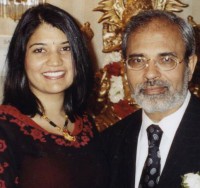 Jaysri Chasmawala’s family is from India. She was born in Boston, and growing up she remembers her father as a devout practitioner of the Ramanuja Sampradaya who provided her first spiritual inspiration. (Later in life, two weeks before leaving his body, he accepted initiation from H.H. Giriraj Swami). As children they often frequented ISKCON temples. Later on, as school demands increased, the visits to the temple became less regular, although Jaysri’s spiritual quest continued. She eventually found her heart’s yearning satisfied back at the Krsna temples she knew from her earlier childhood, and by her senior year in high-school, she and her family renewed their visits.
Jaysri Chasmawala’s family is from India. She was born in Boston, and growing up she remembers her father as a devout practitioner of the Ramanuja Sampradaya who provided her first spiritual inspiration. (Later in life, two weeks before leaving his body, he accepted initiation from H.H. Giriraj Swami). As children they often frequented ISKCON temples. Later on, as school demands increased, the visits to the temple became less regular, although Jaysri’s spiritual quest continued. She eventually found her heart’s yearning satisfied back at the Krsna temples she knew from her earlier childhood, and by her senior year in high-school, she and her family renewed their visits.

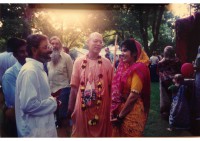 While in College in Austin, TX, the struggle was hard, but devotees continuously reached out to her, inviting her to their programs. After repeated turn-downs and while visiting the family in Fort Worth for a holiday, she finally made it to a program at the Dallas temple. There she – literally – ran into who was to become her spiritual master, Srila Tamal Krishna Goswami Maharaja. His lecture touched the core of her heart; his talk was relevant and helped solidify her attachment to Krsna. She then read – almost “devoured” – his book Yoga for the 21st Century and felt inspired with a new sense of dedication to her spiritual path. She picked up her chanting and a year later, in the summer of 1996, on Bhima (Nirjala) Ekadasi, she received her first initiation.
While in College in Austin, TX, the struggle was hard, but devotees continuously reached out to her, inviting her to their programs. After repeated turn-downs and while visiting the family in Fort Worth for a holiday, she finally made it to a program at the Dallas temple. There she – literally – ran into who was to become her spiritual master, Srila Tamal Krishna Goswami Maharaja. His lecture touched the core of her heart; his talk was relevant and helped solidify her attachment to Krsna. She then read – almost “devoured” – his book Yoga for the 21st Century and felt inspired with a new sense of dedication to her spiritual path. She picked up her chanting and a year later, in the summer of 1996, on Bhima (Nirjala) Ekadasi, she received her first initiation.
 When she then went onto MED school in Fort Worth, her spiritual master, Srila Tamal Krishna Goswami, offered much encouragement. He especially appreciated her preventative approach to health, which was and still is the focus of her practice. She fondly remembers the many opportunities she got to serve him his meals. On one particular occasion, when she assisted another doctor with preparing and serving a meal, Srila Tamal Krishna Goswamai complained about the quality of the food and jokingly made a statement that “Doctors can’t cook”. When he asked her if she could cook well and she said she couldn’t, he teased: “Become a doctor then!”
When she then went onto MED school in Fort Worth, her spiritual master, Srila Tamal Krishna Goswami, offered much encouragement. He especially appreciated her preventative approach to health, which was and still is the focus of her practice. She fondly remembers the many opportunities she got to serve him his meals. On one particular occasion, when she assisted another doctor with preparing and serving a meal, Srila Tamal Krishna Goswamai complained about the quality of the food and jokingly made a statement that “Doctors can’t cook”. When he asked her if she could cook well and she said she couldn’t, he teased: “Become a doctor then!”
She fondly recalls many loving exchanges and funny incidents. He would take the time to personally check on her and show his fatherly affection. His genuine care for her touched her deeply.
 In 2007, with the goal of being close to the devotee community, Jaysri established her private clinic in the Lakewood neighborhood, just a few minutes’ drive from Sri Sri Radha Kalachandji’s Temple. Eventually, she took the Integrative Holistic Board Exam and decided to further focus her practice on natural methods and started seeing patients at a devotee’s local Yoga Studio. She openly promotes a healthy lifestyle to all she encounter, which includes plant-based diet and meditation. She often encourages her patients to pick up the Hare Krsna mantra chanting as a recommended form of personal meditation.
In 2007, with the goal of being close to the devotee community, Jaysri established her private clinic in the Lakewood neighborhood, just a few minutes’ drive from Sri Sri Radha Kalachandji’s Temple. Eventually, she took the Integrative Holistic Board Exam and decided to further focus her practice on natural methods and started seeing patients at a devotee’s local Yoga Studio. She openly promotes a healthy lifestyle to all she encounter, which includes plant-based diet and meditation. She often encourages her patients to pick up the Hare Krsna mantra chanting as a recommended form of personal meditation.
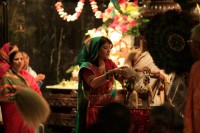
 She received second initiation from His Holiness Giriraj Swami Maharaja in 2011 and immediately began her deity services. She then moved to the immediate temple neighborhood. On several days a week, Jaysri dresses the deities. When asked which she loves the most, she answers with a smile: “I love Them all! I can’t fathom ever giving up my service to any of Them! No matter what else is going on, when I’m on the altar, nothing else matters. It’s so wonderful.”
She received second initiation from His Holiness Giriraj Swami Maharaja in 2011 and immediately began her deity services. She then moved to the immediate temple neighborhood. On several days a week, Jaysri dresses the deities. When asked which she loves the most, she answers with a smile: “I love Them all! I can’t fathom ever giving up my service to any of Them! No matter what else is going on, when I’m on the altar, nothing else matters. It’s so wonderful.”
Why did she decide to donate to TKG Academy? “One thing that really stands out to me is that TKG Academy students seem more intelligent and self-confident than other children that I meet. I attribute that to the emphasis on creativity and arts as much as the academic curriculum. Since Kirtan is a big part of our philosophy, the children are taught to participate in and lead Kirtans early and often. Whether it is singing or playing musical instruments, they have a wonderful outlet to engage their creative side. Studies show that creativity and music increase focus, clarity and positively shape developing minds. Children are more ready to delve into their studies and have better retention. While most schools cut back on music and art programs or de-emphasize their importance, TKG Academy highlights those as important as the academics. This kind of creative outlet also increases self-confidence.
I decided to donate to the school because I think that what TKG Academy is doing is great. The more individualized curriculums for the students and the small teacher to student ratio are important in shaping the minds of future generations. I do not plan on having children of my own and donating to this institution is my way of contributing to future Krishna devotees. And if for some reason I do have a child, well, then I know where I want to send him/her.”
Jayshri Chasmawala, D.O., is a Board Certified Family Practice and Integrative Holistic Medicine physician with Pure Health Family Practice in the East Dallas community. She provides excellent quality healthcare in a warm, loving, and compassionate environment. She uses a holistic approach focusing on wellness and prevention while educating patients on health as well as smart lifestyle choices. She emphasizes the crucial role nutrition plays in health. Dr. Chasmawala is also the Medical Director at MedPost Urgent Care. She oversees patient care in an urgent care environment and works there a few days a week.
Dr. Chasmawala’s educational background includes a 2002 Doctor of Osteopathy from the University of North Texas College of Osteopathic Medicine. In 2004 she received her Masters in Public Health from UNT’s School of Public Health where her research focused on eating disorders. She completed her residency at Houston’s Christus St. Joseph Family Practice Residency Program in 2005. She recently achieved board certification in Integrative Holistic Medicine. Her dual educational background, continuing medical education endeavors and interest in weight management complement her goal to properly address her patients’ needs of all ages. She is fluent in Spanish, Hindi, and Gujarati.
Dr. Chasmawala is from a loving family, which includes her parents, a sister and two brothers. The family has resided in Fort Worth, Texas since 1986. She lives in Dallas, enjoys the wealth of activities available, and is still close to her family. She lives what she “preaches” regarding nutrition and exercise. She is an exercise enthusiast and in the past has participated in several half-marathons and a sprint triathlon among other events. She follows a vegetarian/ vegan lifestyle with a focus on whole food plant based nutrition.
HH Jayapataka Swami completed his 45 years of accepting…
→ Dandavats.com

HH Jayapataka Swami completed his 45 years of accepting sannyasa. In fact, he’s the longest standing sannyasi in Iskcon. On the auspicious day of Radhastami in the age of 21 ISKCON Founder-acharya His Divine Grace Srila A. C. Bhaktivedanta Swami Prabhupada blessed him with the life of renunciation.
Fight on the strength of love
→ KKSBlog
(Kadamba Kanana Swami, 04 April 2010, Durban, South Africa, Lecture)
 As devotees, we are people with mixed feelings. We have feelings of attraction towards Krsna and we have feelings of attraction towards the material energy. So, every devotee has within himself a dilemma. Therefore, sometimes, spiritual life is described to be a war on maya, in other words, a fight with ourselves. It is not so easy to fight this fight but when you fight this fight on the strength on knowledge, on the strength of deeper understanding of the long-term benefits of following spiritual principles, then this gives some relief but still, it is difficult because on the basis of knowledge, how long can you fight!? Ultimately, we have to fight on the strength of love. We must love our spiritual activities. If we love Krsna consciousness, then we will never be defeated!
As devotees, we are people with mixed feelings. We have feelings of attraction towards Krsna and we have feelings of attraction towards the material energy. So, every devotee has within himself a dilemma. Therefore, sometimes, spiritual life is described to be a war on maya, in other words, a fight with ourselves. It is not so easy to fight this fight but when you fight this fight on the strength on knowledge, on the strength of deeper understanding of the long-term benefits of following spiritual principles, then this gives some relief but still, it is difficult because on the basis of knowledge, how long can you fight!? Ultimately, we have to fight on the strength of love. We must love our spiritual activities. If we love Krsna consciousness, then we will never be defeated!
Hare Krishna! Offer it Up!
Ananda Vrindavana Devi Dasi: I…
→ Dandavats.com

Hare Krishna! Offer it Up!
Ananda Vrindavana Devi Dasi: I learned how to offer at a young age. When I didn’t want to carry the freshly ironed clothes upstairs my mother would cheerfully say, “Offer it up!”. There was no choice about having to do it but she was suggesting where I put my mind in the process. She was teaching me to offer this small activity to God. Those three words stayed with me, and when I was later introduced to Krishna consciousness, the same concept from my childhood appeared to me in Krishna’s teachings. What does it mean to offer? With the clothing, it meant that I did something I didn’t want to do for someone else. I turned this unwelcome activity into a gesture of goodwill. I took the time that I’d rather be doing something else, and gave it away or offered it up.
Read the entire article here: http://www.dandavats.com/?p=20017
On our way to Budapest
→ SivaramaSwami.com
Danavir dasa asks whether other ages have a presiding deity as this age has Kali.
The post On our way to Budapest appeared first on SivaramaSwami.com.
Kirtan party in the temple of Copenhagen (Album with…
→ Dandavats.com

Kirtan party in the temple of Copenhagen (Album with photos)
Saturday 19 September.
Find them here: https://goo.gl/zGNrJq
Hare Krishna devotees back to Croome Court for a day (Album with…
→ Dandavats.com

Hare Krishna devotees back to Croome Court for a day (Album with photos)
The International Society for Krishna Consciousness bought Croome Court in 1979 when famous devotee, George Harrison, reputedly released funds for the purchase to use the Grade I listed mansion as their headquarters. After stamping their own unique mark on the house, which can be seen in the Dining Room decoration scheme over the weekend, they chose to relocate in Watford at Bhaktivedanta Manor which was also bought for them by the world-famous Beatles lead guitarist.
Find them here: https://goo.gl/rNRgQJ
Hare Krishna! Srila Jiva Gosvami’s Disappearance
Gour Govinda…
→ Dandavats.com

Hare Krishna! Srila Jiva Gosvami’s Disappearance
Gour Govinda Swami: “A Vaisnava does not take birth under the jurisdiction of karmic law. His birth and disappearance are transcendental. The wise have declared that the servants of Visnu are eternally engaged in the liberated service of the Lord and hence are free from the laws of material nature.” (Padma Purana, quoted in the Hari-bhakti-vilasa, 10.113) Srila Jiva Gosvami was the youngest but most prolific writer among the Gosvamis. He wrote an astounding half million Sanskrit verses (about 25 books). When Srila Jiva Gosvami left this world many said that no one like him would ever appear on the planet again.
Read the entire article here: http://www.dandavats.com/?p=20013



